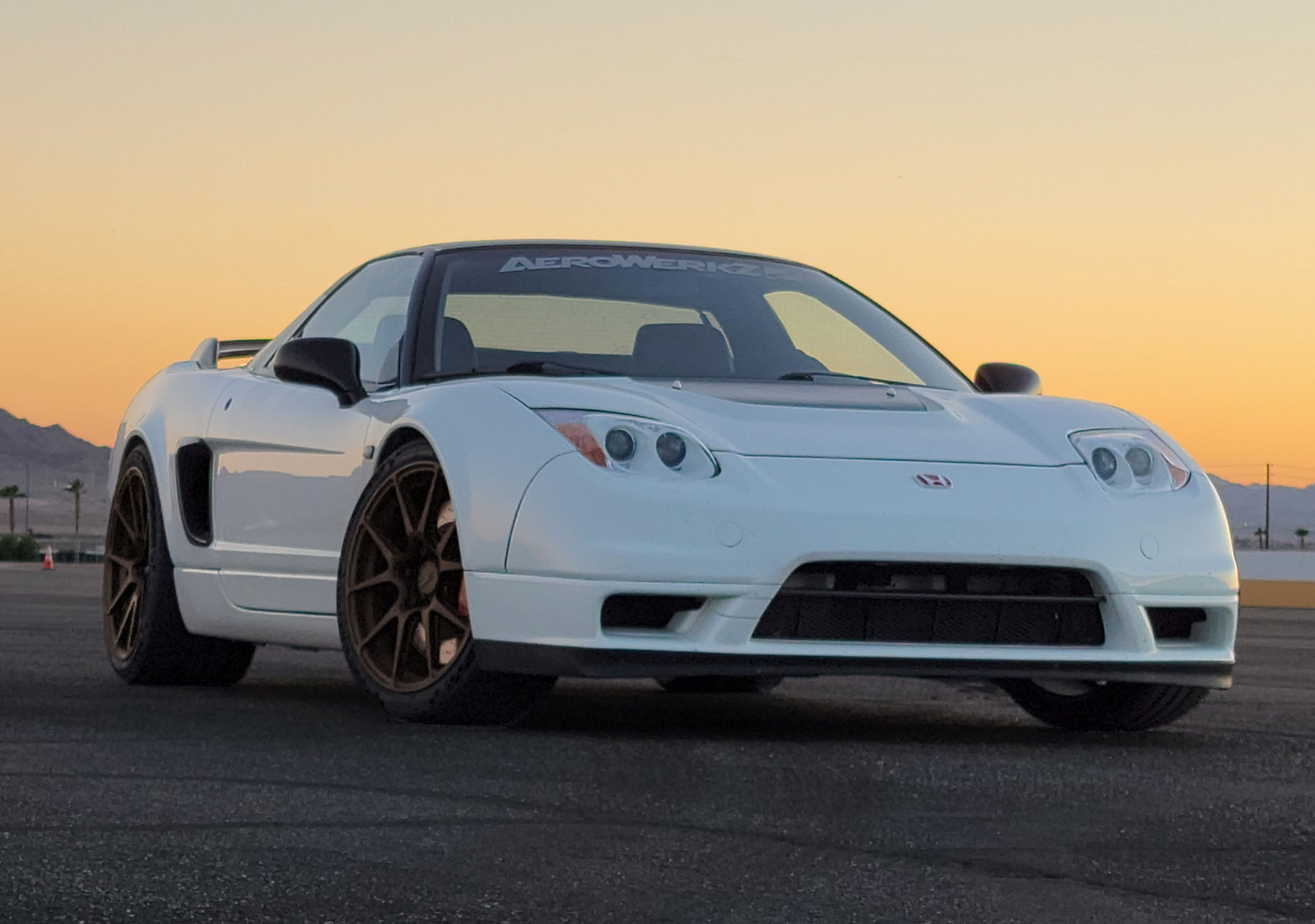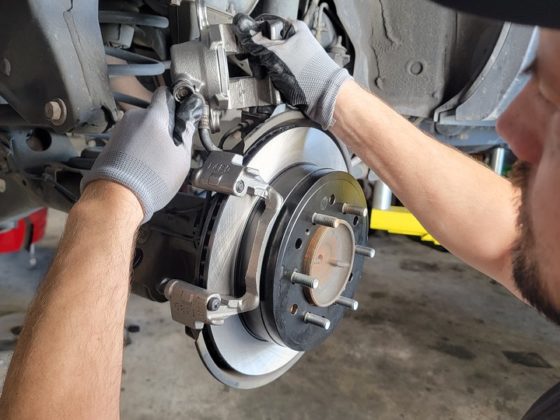After years of extensive testing and measuring, I finally fit 305-width Michelin Cup 2 (240)s under the rear of an NSX, mounted on a set of custom Forgeline GA1R wheels.
 I am a big fan of Michelin. I’ve raced on their tires in the 24 Hours of LeMans driving the No.66 Ford GT and worked with them to create bespoke Cup 2 tires for cars like the Ford GT, Shelby GT350-R and GT500. This experience has made me desperately want the level of on-track grip, comfort, quietness, refinement, and overall performance of the Cup 2 for my NSX.
I am a big fan of Michelin. I’ve raced on their tires in the 24 Hours of LeMans driving the No.66 Ford GT and worked with them to create bespoke Cup 2 tires for cars like the Ford GT, Shelby GT350-R and GT500. This experience has made me desperately want the level of on-track grip, comfort, quietness, refinement, and overall performance of the Cup 2 for my NSX.
Unfortunately, the Cup 2 was never offered in NSX-friendly 17” or 18” sizes. With the help of the wider fenders that we installed in Part 8, and after a significant amount of testing and measuring on 18/19” wheels, I finally figured out how to stuff modern sportscar-width Cup 2 tires fit on an NSX.
I decided on a 245/35-18 front tire, and a massive 305/30-19 rear tire. This happens to the staggered width of most modern track-focused Porsches, McLarens, and Ferraris. The new Michelin Cup 2 (240) “Connect” tire is the second-generation Cup 2 that I talked about in my article Not All Cup 2 Tires Are Created Equal.
 In order to do this, we needed a set of custom width and offset wheels. Forgeline stepped up the plate with their GA1R Open Lug wheel. I’ve won a lot of races on this exact wheel design, which features an open center lug design that helped make pit stops faster on the GS-class Roush Performance Mustang race cars that I competed in. This was a game-changing competitive advantage in the pit lane, and a special design feature I’m proud to have on Project NSX.
In order to do this, we needed a set of custom width and offset wheels. Forgeline stepped up the plate with their GA1R Open Lug wheel. I’ve won a lot of races on this exact wheel design, which features an open center lug design that helped make pit stops faster on the GS-class Roush Performance Mustang race cars that I competed in. This was a game-changing competitive advantage in the pit lane, and a special design feature I’m proud to have on Project NSX.
 Now this has been a long journey that started with testing the 18/19” wheel stagger on the NSX using Advan RSii wheels. This large wheel setup has historically been reserved for the “big-wheel” NSX crowd that didn’t care much for what rubber they stretched around their blingy wheels. But as the saying goes: necessity drives innovation; and as 17/17 and 17/18 tire options started to dwindle, I looked for a solution in larger sizes.
Now this has been a long journey that started with testing the 18/19” wheel stagger on the NSX using Advan RSii wheels. This large wheel setup has historically been reserved for the “big-wheel” NSX crowd that didn’t care much for what rubber they stretched around their blingy wheels. But as the saying goes: necessity drives innovation; and as 17/17 and 17/18 tire options started to dwindle, I looked for a solution in larger sizes.
I first tested 235/40-18 and 275/35-19 tires which are an extremely common, modern size that virtually every tire that matters are available in. Including the Michelin Cup 2. I chose the Nitto NT05 in these sizes to push the limits of the platform and see what it takes to make them work. This was the tire that I set a really fast time at Buttonwillow using the standard 17/18 tire stagger and my goal was to compare 17/18 vs 18/19 using the same tire.
Unfortunately, after months of testing this setup and modifying the car, the 25.5” front outer diameter of the 235/40-18 tire was just too large to work in a wheel well designed for a 23” diameter 205/50-15 tire. Plus, it raised the ride height by over an inch, which is not good for looks, handling, or performance.
 From the knowledge in my article How to PROPERLY select and size TIRES for PERFORMANCE, it’s crucial to start by choosing and sizing a tire before selecting a wheel. Since I wanted the Cup 2, and my testing determined that 235/40-18 was too large, I decided on a 245/35-18 which is 0.7” smaller in diameter and is a popular size that’s available in other high performance tire models. This size is a full 1” larger than the OEM-sized 215/40-17 front tire, which is far more reasonable than trying to stuff a tire that’s 1.7” larger.
From the knowledge in my article How to PROPERLY select and size TIRES for PERFORMANCE, it’s crucial to start by choosing and sizing a tire before selecting a wheel. Since I wanted the Cup 2, and my testing determined that 235/40-18 was too large, I decided on a 245/35-18 which is 0.7” smaller in diameter and is a popular size that’s available in other high performance tire models. This size is a full 1” larger than the OEM-sized 215/40-17 front tire, which is far more reasonable than trying to stuff a tire that’s 1.7” larger.
Out back, I chose a 305/30-19 rear tire to have a more modern supercar tire stagger, to stay within the ABS tolerance of the NSX, and increase rear grip which is usually the limiting factor of the NSX. This rear tire has a 11.0” treadwidth and based on my general rule of thumb of sizing a wheel 0.5” wider than the tread width for the best handling and grip, we would need an 11.5” rear wheel and a 9” front wheel for the 8.6” wide front tire.




9 comments
Jesus Christ, that is one great-looking car! That massive rubber and functional stance really bring out the purpose of the NSX.
Thank you very much. It took a lot of planning and testing but i’m extremely happy with how everything came together visually and performance wise. Stay tuned for when we track test and compare it to standard 17/18 tire sizes!
Billy, you are making the best content out there on car websites right now. Keep it up. I also enjoyed seeing you in Dahm’s RX7 series!
Thank you for the kind words. I’m trying to put out unique and interesting content. Spread the word! 🙂
There will be more Project FD RX7 Restomod coming up soon, so keep an eye out!
Thanks for including the wheel and tire weights. Pretty amazing that you could add that much tire and still lose some unsprung weight.
Now you just need a twin-turbo and sequential gearbox to make the ultimate NSX!
“Plus, it raised the ride height by over an inch, which is not good for looks, handling, or performance.”
Do you have any idea if dropping an inch (going the other way) would help handling?
My logic as to why it may work, preserves suspension geometry, reduces unsprung weight, opens up possibility for cheap, fun tyres.
Reasons why it may not work, ground clearance.
The 1 inch smaller diameter tire will drop the ride height 0.5″ without any other change, which is a win-win. The ability to lower it another 0.5″ from a fender clearance standpoint will have benefits and negatives (lower center of gravity, but less ideal suspension geometry). Depending on the rest of the setup this can be good or bad, but typically it will still be good. Ground clearance isn’t an issue on track.
Thank you so much.
I’m a casual driver and would like to get a set of spare rims for track tyres. I’d like to go to 16″ down from my stock 17″ and maintain the tire sidewall height.
All this time I didn’t realize you were the wheelman with the Mustang too. Hopefully other tire manufacturers start offering stuff like this, namely Toyo as I’m required to run their tires in my series. It would be awesome to datalog tire temps and pressures over the course of a race.